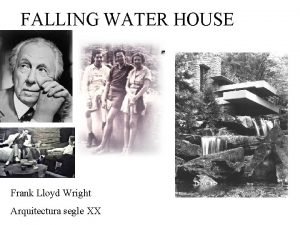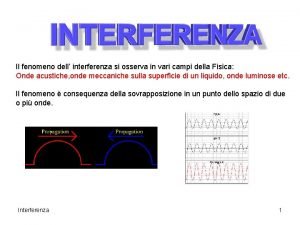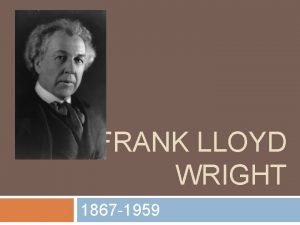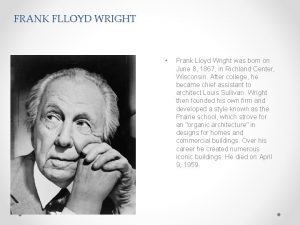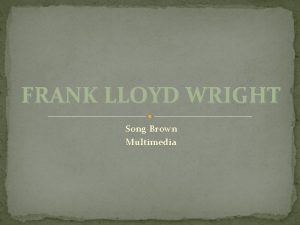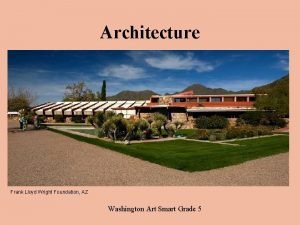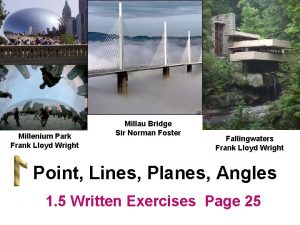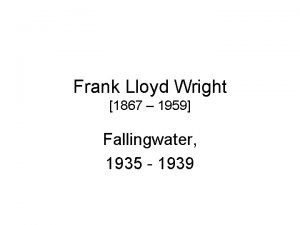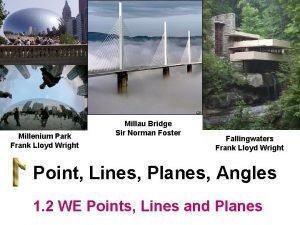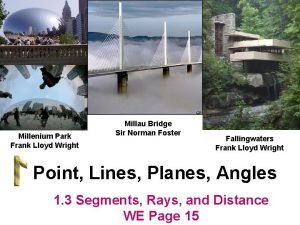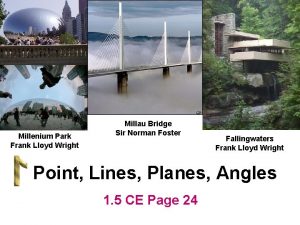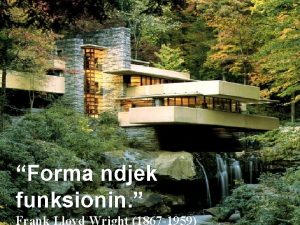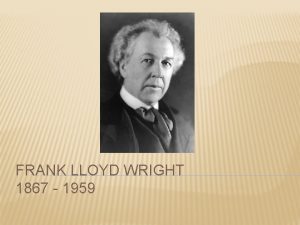FRANK LLOYD WRIGHT life projects Frank Lloyd Wright




















- Slides: 20

FRANK LLOYD WRIGHT life & projects


Frank Lloyd Wright was a modern architect who developed an organic and distinctly American style. He designed numerous iconic buildings.

“ Study nature, love nature, stay close to nature. It will never fail you. ”

Who Was Frank Lloyd Wright? Frank Lloyd Wright was born on June 8, 1867, in Richland Center, Wisconsin. After college, he became chief assistant to architect Louis Sullivan. Wright then founded his own firm and developed a style known as the Prairie school, which strove for an "organic architecture" in designs for homes and commercial buildings. Over his career he created numerous iconic buildings. He died on April 9, 1959.

“ Less is only more where more is no good. ”

What Was Frank Lloyd Wright's Style? Wright perfected a distinctly American style of architecture that emphasized simplicity and natural beauty in contrast to the elaborate and ornate architecture that had prevailed in Europe. He believed buildings should serve to honor and enhance the natural beauty surrounding them.

“ The longer I live, the more beautiful life becomes. ”

How Many Buildings Did Frank Lloyd Wright Design? With seemingly superhuman energy and persistence, Wright designed more than 1, 100 buildings during his lifetime, nearly one-third of which came during his last decade.

“ Space is the breath of art. ”

Prairie School Architecture A year later, Wright began an apprenticeship with the Chicago architectural firm of Adler and Sullivan, working directly under Louis Sullivan, the great American architect best known as "the father of skyscrapers. " Sullivan, who rejected ornate European styles in favor of a cleaner aesthetic summed up by his maxim "form follows function, " had a profound influence on Wright, who would eventually carry to completion Sullivan's dream of defining a uniquely American style of architecture. Wright worked for Sullivan until 1893, when he breached their contract by accepting private commissions to design homes, and the two parted ways. In 1889, a year after he began working for Louis Sullivan, the 22 -year-old Wright married a 19 year-old woman named Catherine Tobin, and they eventually had six children together. Their home in the Oak Park suburb of Chicago, now known as the Frank Lloyd Wright home and studio, is considered his first architectural masterpiece. It was there that Wright established his own architectural practice upon leaving Adler and Sullivan in 1893. That same year, he designed the Winslow House in River Forest, which with its horizontal emphasis and expansive, open interior spaces is the first example of Wright's revolutionary style, later dubbed "organic architecture. "

The Prairie Style

Over the next several years, Wright designed a series of residences and public buildings that became known as the leading examples of the "Prairie School" of architecture. These were single-story homes with low, pitched roofs and long rows of casement windows, employing only locally available materials and wood that was always unstained and unpainted, emphasizing its natural beauty. Wright's most celebrated "Prairie School" buildings include the Robie House in Chicago and the Unity Temple in Oak Park. While such works made Wright a celebrity and his work became the subject of much acclaim in Europe, he remained relatively unknown outside of architectural circles in the United States.

Fallingwater Residence By the mid-1930 s, approaching 70 years of age, Wright appeared to have peacefully retired to running his Taliesin Fellowship, before suddenly bursting back onto the public stage to design many of the greatest buildings of his life. Wright announced his return to the profession in dramatic fashion in 1935 with Fallingwater, a residence for Pittsburgh's acclaimed Kaufmann family. Where Is Frank Lloyd Wright's Fallingwater House Located? Shockingly original and astonishingly beautiful, Fallingwater is marked by a series of cantilevered balconies and terraces constructed atop a waterfall in rural southwestern Pennsylvania. It remains one of Wright's most celebrated works, a national landmark widely considered one of the most beautiful homes ever built.

VIEW OF FALLINGWATER HOUSE

Then, in the late 1930 s, Wright constructed about 60 middle-income homes known as "Usonian Houses. " The aesthetic precursor to the modern "ranch house, " these sparse yet elegant houses employed several revolutionary design features such as solar heating, natural cooling and "carports" for automobile storage. During his later years, Wright also turned increasingly to designing public buildings in addition to private homes. He designed the famous SC Johnson Wax Administration Building that opened in Racine, Wisconsin, in 1939. In 1938, Wright put forth a stunning design for the Monona Terrace civic center overlooking Lake Monona in Madison, Wisconsin, but was unable to move forward with construction after failing to secure public funding.

MASTER ROOM TERRACE 2 GUEST ROOM TERRACE 1 FALLINGWATER HOUSE SECOND FLOOR PLAN TERRACE 3

INSIDE OF FALLINGWATER HOUSE


mustafa yekeler 200003735 İnterior design
 Frank lloyd wright maison sur la cascade
Frank lloyd wright maison sur la cascade Frank lloyd wright bridge
Frank lloyd wright bridge Frank lloyd wright falling water
Frank lloyd wright falling water Frank lloyd wright apush
Frank lloyd wright apush Frank william abagnale, jr.
Frank william abagnale, jr. Lloyd boggio
Lloyd boggio Mary lloyd ireland md
Mary lloyd ireland md Prewriting techniques definition
Prewriting techniques definition Constance lloyd
Constance lloyd Constance lloyd
Constance lloyd Constance lloyd
Constance lloyd Lloyd kwast
Lloyd kwast Espejo de lloyd
Espejo de lloyd Specchio di lloyd
Specchio di lloyd Oglinda lloyd
Oglinda lloyd Classificazione fibre nervose lloyd
Classificazione fibre nervose lloyd Lloyd layman size up
Lloyd layman size up Rockmusical webber 1984
Rockmusical webber 1984 Lloyd davies position
Lloyd davies position Facts about william lloyd garrison
Facts about william lloyd garrison Lloyd braithwaite theory
Lloyd braithwaite theory


